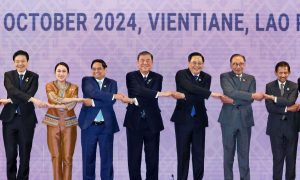Is an “Asian NATO” Tokyo’s next big move? Japan’s newly appointed Prime Minister Ishiba Shigeru has long supported such a security grouping – but he appears to have miscalculated the strategic impact of his pitch.
Beijing has fiercely critiqued the Quad as an “Asian NATO,” and views the United States’ Indo-Pacific Strategy as a “5-4-3-2” formulation – with the Five Eyes, Quad, AUKUS, and a range of bilateral security treaties – designed to contain China.
The United States’ Asian allies – including Japan and South Korea together with Australia and New Zealand, often called the “Indo-Pacific 4” – have intensified cooperation with NATO following the Russian invasion of Ukraine. Even so, Ishiba’s idea of forming an Asian NATO is farfetched. Pushing the idea will most certainly alienate key Indo-Pacific stakeholders, including India and ASEAN.
While Ishiba identifies himself as a “defense otaku” or “defense geek,” the lack of sharp strategic clarity in his policy pronouncements creates ambiguity. The conversation amongst the strategic analysts in Tokyo underscores the contradictions emerging between the concepts of “collective defense” and “collective security” in Ishiba’s articulations, leading to confusion.
Ishiba has been an advocate of an Asian NATO, but his word carries new weight now that he is prime minister, rather than a political outsider within even his own party. Floating half-baked ideas without proper domestic debate should be avoided, particularly for Japan. The political rhetoric of a “normal” Japan often stirs up issues of nationalism, history, and memory politics in East Asia.
Ishiba’s Asian NATO pitch has already stumbled at the regional stage. It will not feature on the high-table during his debut in the ASEAN-related summits this week. Foreign Minister Iwaya Takeshi is attempting to calm the tremors across the Indo-Pacific by suggesting that an Asian NATO is an idea that should be considered over the medium-to-long term.
In his article for the Hudson Institute, a U.S. think tank, Ishiba argued for the need to create a collective self-defense system in Asia:
[T]he absence of a collective self-defense system like NATO in Asia means that wars are likely to break out because there is no obligation for mutual defense. Under these circumstances, the creation of an Asian version of NATO is essential to deter China by its Western allies.
In some explanations of this idea, Ishiba shows particular concern for the need to deter China from invading Taiwan. In his conversation with Taiwanese President Lai Ching-te earlier this year, Ishiba stressed the need for a coalition of democracies boosting cumulative deterrence. However, on other occasions, he has shown his openness to the idea of a collective security arrangement the includes China.
In addition, the reality remains that Tokyo still cannot fully exercise collective self-defense within its existing constitutional constraints.
Notably, Ishiba’s propositions in the Hudson paper did not coherently flow into his first policy speech in the Japanese Diet. In fact, his speech largely avoided his more controversial positions, forgoing not just any reference to an “Asian NATO” but also the contentious ideas of strengthening nuclear deterrence and nuclear sharing, which contradict Japan’s three non-nuclear principles. Since taking office, Ishiba has also been quiet on his previous calls for balancing asymmetry in the Japan-U.S. alliance by reforming the Status of the Forces Agreement (SOFA) and basing Japanese forces in Guam.
On the contrary, his policy speech to a certain degree reflected an extension of the Kishida line. For instance, Ishiba’s declaration that “Ukraine today may be East Asia tomorrow” is straight out of Kishida’s playbook. Similarly, his comments on bolstering deterrence capabilities to ensure peace and fundamentally strengthening Japan’s defense capabilities also echoes successive administrations efforts.
His China policy shows a dual approach, advocating both deterrence while deepening dialogue to “promote a mutually beneficial relationship based on common strategic interests.” Ishiba pledged to pursue “close communication [with China] at all possible levels.”
While Japan’s 2022 National Security Strategy did identify Beijing as the “greatest strategic challenge,” former Prime Minister Kishida subsequently returned to the description of China-Japan ties as a “mutually beneficial relationship based on common strategic interests” – a formula originally used by Abe Shinzo and Hu Jintao in 2006.
While Ishiba’s foreign policy vision as prime minister remains in flux, the heated domestic political debate casts doubt over the new prime minister’s ability to secure political stability. Japan is navigating a season of elections: the lower house election later this month and the upper house election next year. Depending on the LDP’s performance in these polls, Ishiba’s tenure may yet prove short-lived.
In contrast to Kishida’s reputation as a consensus builder, Ishiba has long remained anti-mainstream within the factional mosaic of the ruling Liberal Democratic Party (LDP). Ishiba is the antithesis of the Abe-Aso power base, but he enjoyed popular support.
In his book, Ishiba identified himself as a conservative-liberal. While his guru was former Prime Minister Tanaka Kakuei, the waning of the Tanaka school’s influence in Japanese politics in the 1980s and the rise of the Kishi school in the post-Cold War decades made way for the Abe era.
While Kishida dissolved traditional factions to help burnish the LDP’s credentials following successive scandals in recent times, a fair share of challenges await Ishiba as the LDP remains deeply divided. His failure to include Abe’s protegee, Takaichi Sanae, in key party positions despite her second-place finish in the recent LDP elections risks alienating the larger base of Abe loyalists. That may prove fatal for Ishiba in the upcoming elections.
If Ishiba continues to lead Japan in the coming months, and with a new president entering the White House in January 2025, he can hardly afford to present ideas without imparting strategic clarity. The international community is keenly awaiting Ishiba’s vision for Japan and its role in the international system.

































